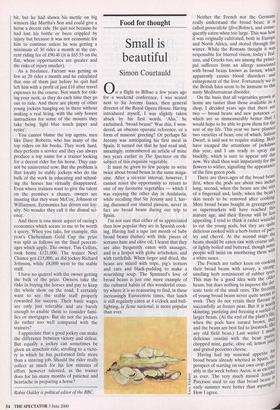Food for thought
Small is beautiful
Simon Courtauld
0 n a flight to Bilbao a few years ago for a weekend conference, I was seated next to Sir Jeremy Isaacs, then general director of the Royal Opera House. Having introduced myself, I was slightly taken aback by his first words. `Aha,' he exclaimed, 'broad beans!' Was this, I won- dered, an obscure operatic reference, or a form of masonic greeting? Or perhaps Sir Jeremy was anticipating his first meal in Spain. It turned out that he had read and, amazingly, remembered an article of mine two years earlier in The Spectator on the subject of this exquisite vegetable.
It must be given to few people to write twice about broad beans in the same maga- zine. After a six-year interval, however, I cannot resist the opportunity to return to one of my favourite vegetables — which I was enjoying the other day in Andalusia, while recalling that Sir Jeremy and I, hav- ing discussed our shared passion, never in fact ate broad beans during our trip to Spain.
I'm not sure that either of us appreciated then how popular they are in Spanish cook- ing. Having had a tapa last month of baby broad beans (habas) with little pieces of serrano ham and olive oil, I learnt that they are also frequently eaten with sausages, and in a hotpot with globe artichokes, and with cuttlefish. When larger and dried, the beans are mixed with tripe, pig's trotters and ears and black-pudding to make a nourishing soup. The Spaniard's love of broad beans is just one more example of the cultured habits of this wonderful coun- try where it is so reassuring to find, in these increasingly Eurocentric times, that lunch is still regularly eaten at 4 o'clock and bull- fighting, la fiesta nacional, is more popular than ever. Neither the French nor the Germans really understand the broad bean; it is called grosseldicke (feve/Bohne), and conse- quently eaten when too large. This was how it was originally cultivated, both in Europe and North Africa, and stored through the winter. While the Romans thought it was responsible for blurred vision, today's Ital- ians, and Greeks too, are among the princi- pal sufferers from an allergy associated with broad beans known as favism, which apparently causes blood disorders and enlargement of the liver. Fortunately we in the British Isles seem to be immune to this nasty Mediterranean disorder. On the basis that all vegetables grown at home are tastier than those available in a shop, I decided years ago that there are two — broad beans and new potatoes --- which are so immeasurably better that I would hope to be able to grow them for the rest of my life. This year we have planted two varieties of bean, one of which, Sutton Dwarf, is said not to require staking. Both have escaped the attentions of jackdaws this year, and I am ready to spray the blackfly, which is sure to appear any day now. We shall then wait impatiently for the flowers to wither, signalling the appearance of the first green pods. There are three. ages of the broad bean: first, when the pods are about two inches long, second, when the beans are the size of a fingernail and, lastly, when the beans skin needs to be removed after cooking' Most broad beans bought in greengrocers or supermarkets will have reached mature age, and their flavour will be less appealing. I tend to think it rather wasteful to eat the young pods, but they are quite delicious cooked with a herb butter of Pars- ley and chervil. At the second stage the beans should be eaten raw with coarse salt, or lightly boiled and buttered, though sortie people will insist on smothering them with a white sauce. The French are rather keen on cooking their broad beans with savory, a strong' smelling herb reminiscent of rubber Vies' This may be a good idea with the older beans, but does nothing to improve the de' icate taste of the small ones. The freezirlF, of young broad beans never quite seems to work. They do not retain their flavour 4,31, successfully as frozen peas. But it is worth skinning, pureeing and freezing a surfeit 01 larger beans. (At the end of the planes life, when the pods have turned brown, ilt! and the beans are best fed to livestock, II"' any old field bean.) Last winter I made delicious delicious crostini with the bean Pl:ic`.ce chopped mint, garlic, olive oil, lemon Jull and grated pecorino cheese. Having had my seasonal appetite e broad beans already whetted in Spain, r,, nror prospect of starting on our own crop, r ably in the week beforc Ascot, is as exeit.11/6 tufa as ever. The very much missed Jell Paterson used to say that broad beans t. early summer were better than asparagus How I agree.





































































 Previous page
Previous page